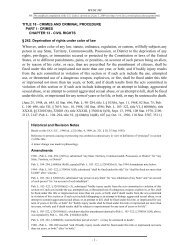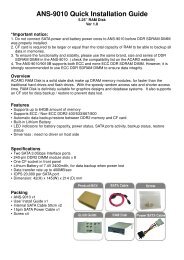2004 Instructions for Form 1040 (ALL) - Supreme Law Firm
2004 Instructions for Form 1040 (ALL) - Supreme Law Firm
2004 Instructions for Form 1040 (ALL) - Supreme Law Firm
You also want an ePaper? Increase the reach of your titles
YUMPU automatically turns print PDFs into web optimized ePapers that Google loves.
Major Categories of Federal Income and Outlays <strong>for</strong> Fiscal Year 2003<br />
Income and Outlays. These pie charts show the relative sizes of the major categories of federal income and outlays <strong>for</strong> fiscal year 2003.<br />
Income<br />
Social security, Medicare,<br />
and unemployment and other<br />
retirement taxes<br />
33%<br />
Personal income<br />
taxes<br />
37%<br />
Outlays<br />
<strong>Law</strong> en<strong>for</strong>cement and<br />
general government<br />
3%<br />
Social security,<br />
Medicare, and other<br />
retirement 1<br />
37%<br />
Social<br />
programs 4<br />
21%<br />
Borrowing to<br />
cover deficit<br />
17%<br />
Corporate<br />
income taxes<br />
6%<br />
Excise, customs, estate,<br />
gift, and miscellaneous<br />
taxes<br />
7%<br />
Physical, human,<br />
and community<br />
development 3<br />
10%<br />
Net interest on<br />
the debt<br />
7%<br />
National defense,<br />
veterans, and <strong>for</strong>eign<br />
affairs 2<br />
22%<br />
On or be<strong>for</strong>e the first Monday in February outlays were $2.2 trillion, leaving a deficit 3. Physical, human, and community<br />
of each year, the President is required by of $0.4 trillion. development: These outlays were <strong>for</strong> agrilaw<br />
to submit to the Congress a budget<br />
Footnotes <strong>for</strong> Certain Federal<br />
culture; natural resources; environment;<br />
proposal <strong>for</strong> the fiscal year that begins the<br />
Outlays<br />
transportation; aid <strong>for</strong> elementary and secfollowing<br />
October. The budget plan sets<br />
ondary education and direct assistance to<br />
<strong>for</strong>th the President’s proposed receipts, 1. Social security, Medicare, and college students; job training; deposit inspending,<br />
and the surplus or deficit <strong>for</strong> the other retirement: These programs provide surance, commerce and housing credit, and<br />
Federal Government. The plan includes income support <strong>for</strong> the retired and disabled community development; and space, en-<br />
recommendations <strong>for</strong> new legislation as and medical care <strong>for</strong> the elderly.<br />
ergy, and general science programs.<br />
well as recommendations to change, elimi-<br />
2. National defense, veterans, and <strong>for</strong>nate,<br />
and add programs. After receiving the<br />
4. Social programs: About 14% of total<br />
eign affairs: About 18% of outlays were to outlays were <strong>for</strong> Medicaid, food stamps,<br />
President’s proposal, the Congress reviews<br />
equip, modernize, and pay our armed temporary assistance <strong>for</strong> needy families,<br />
it and makes changes. It first passes a<br />
<strong>for</strong>ces and to fund other national defense supplemental security income, and related<br />
budget resolution setting its own targets <strong>for</strong><br />
activities; about 3% were <strong>for</strong> veterans benreceipts,<br />
outlays, and the surplus or deficit.<br />
programs; and the remaining outlays were<br />
efits and services; and about 1% were <strong>for</strong> <strong>for</strong> health research and public health pro-<br />
Next, individual spending and revenue bills<br />
international activities, including military grams, unemployment compensation, as-<br />
that are consistent with the goals of the<br />
and economic assistance to <strong>for</strong>eign counbudget<br />
resolution are enacted.<br />
sisted housing, and social services.<br />
tries and the maintenance of U.S. embas-<br />
In fiscal year 2003 (which began on Oc- sies abroad.<br />
tober 1, 2002, and ended on September 30,<br />
2003), federal income was $1.8 trillion and<br />
Note. The percentages on this page exclude undistributed offsetting receipts, which were $54 billion in fiscal year 2003. In the budget, these receipts are offset against<br />
spending in figuring the outlay totals shown above. These receipts are <strong>for</strong> the U.S. Government’s share of its employee retirement programs, rents and royalties on the<br />
Outer Continental Shelf, and proceeds from the sale of assets.<br />
-74-













